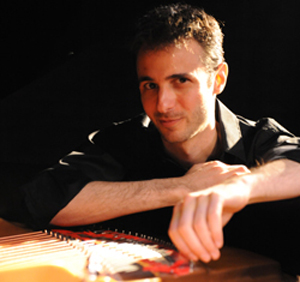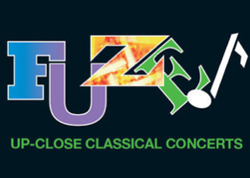By Mike Telin

Tuesday Musical’s choice to present Gregg Kallor on the FUZE! Series is a bit ironic given that his performances and his music are a fusion of classical, jazz and improvisation. But finding commonality between seemingly dissimilar things is a natural part of who Kallor is. He earned a bachelor’s degree in American Studies, a perfect fit for him because, as he said in a recent telephone conversation, “it’s a very open-ended liberal arts major that allowed me to explore literature, history, philosophy, and political science.”
During our conversation I asked Kallor about his music, his decision to pursue a liberal arts degree, and his recent appointment as Composer-In-Residence at Subculture in New York City. I began by asking him what audiences can expect to hear on the 12th.
Gregg Kallor: It’s a mystery! [laughing]. I’m just kidding, but sometimes I like to approach performances that way. It kind of keeps it fresh. Actually this is going to be an exciting concert, half solo piano and half piano and cello with a fantastic cellist, Dave Eggar. He’s joining me for a piece I wrote called Undercurrent. We’ll also play Brahms First Sonata in e minor for cello and piano.

Mike Telin: I’ve enjoyed your music for a couple of years now, but I need to ask: how did you go from being an American Studies major to a career as a pianist/composer who fuses classical with jazz?
GK: I think somebody hit me on the head and I woke up in an alley, and that was the switch [laughing]. It’s been an organic development. I grew up with classical music and jazz, and there were opportunities to get into the musical theatre world as well in the town were I grew up. I would also write music, very poorly, but I would write along with my piano studies. So from the beginning everything was kind of a mix for me.
I did give conservatory a try, but ultimately it wasn’t really resonating for me. So I went to Tufts and decided on American Studies. What I loved about that major is that it draws on so many seemingly disparate but different disciplines, and you would start to draw the connections between these things. There would be an artistic movement that was related to what was going on politically, which would be related to something else. And that’s just how I approach music; it all seems very related to me.
MT: What led you to decide to focus more seriously on composing?
GK: About five or six years ago I really began to think about composing as more of a primary pursuit. Until then, performance had been the main thing and composing was kind of a sideline activity.
I also had this wonderful opportunity: I got a residency at the Aaron Copland House. Every day I woke up at sunrise and was so excited to get up and write. I had the entire day with the house to myself to compose. It was one of the seminal experiences of my life. I realized then that composing is really central to who I am.
MT: Have there been any composers along the way whom you would consider mentors?
GK: Yes, but I have never really studied composition formally except with one person, Herschel Garfein. He’s been great and has guided me along without imposing a particular esthetic for which I am very grateful. It was never an analytical approach to score study and this and that because I already had a decent basis in theory and harmony. It was more about looking at what I brought to the table and assessing it on its own terms. Looking at the craft of composing: have you fleshed it out? — developed it fully? — is it concise? — and what else can you do with it? I have found those sorts of things to be very helpful.
MT: Congratulations on being named the first Composer-In-Residence at Subculture. What will this entail?
GK: It’s a new program for them, so we’ll make some of it up as we go. But it’s a two-year residency. The first year there will be three concerts devoted to my music, and for each of those I will write a new piece and play some previously written pieces. The first concert in September will be solo piano and it falls on the one-year anniversary of the opening of the club, so they’ve asked me to write a new piece celebrating that.
The second concert will feature my own song settings of poetry by Yeats and Dickinson. I’m looking forward to working with [mezzo-soprano] Adriana Zabala again and excited to get to work with [baritone] Matthew Worth for the first time. He actually grew up in the same town that I did.
Cellist Joshua Roman and violinist Miranda Cuckson will be part of the spring concert, which will include music for the two solo instruments and piano as well as a new piano trio. I’m super excited about performing with them for the first time.
MT: I’m really impressed by the sudden rise of smaller club venues that are presenting classical music. Do you have any thoughts as to why this is?
GK: I don’t know if there is an over-arching philosophy behind the movement, but personally I love small venues. Some of my favorite performing and listening experiences have been in somebody’s living room with six people sitting on the floor or couch. You can hear and see everything, it’s so visceral.
I love the big halls — they are extraordinary places — but I do love them more for orchestral performances or big forces because they call for that. If I’m going to a recital at Carnegie Hall and sit in the balcony where I usually do, it is still very special. But I do feel like I am missing a lot because I am removed from it. In a smaller venue it feels like I’m going to hear a friend, particularly at some of these newer venues where the artists will hang out at the bar after the concert.
That is one of the things I love about Subculture. It’s a small concert hall with wonderful tiered seating, no obstructed views, and the acoustics are excellent. And there’s a bar where most of the performers hang out with the people who came to listen. How intimate is that?
There can be an excitement to sitting in a sea of people, but if you’re with 40 people all seeing Miranda Cuckson’s incredible bow arm, that makes the music even more exciting. And it takes on a ‘we are all in this together’ feeling. There is more of a sense of community rather than this huge mass of people. Again I don’t in any way mean to disparage the large concert hall experience, I love them, but there is something very special to me about a small venue experience.
MT: Finally I love the music and videos from your new CD, but tell me a little about the 88 Pianos project.
GK: I can’t take any claim for the project, just credit for having a stroke of good luck. The fantastic organization, Sing for Hope, does a lot of charity work by sending performers into schools, hospitals, underprivileged communities. For the pianos project, they invited local artists to decorate pianos, which Sing for Hope then placed all over the five boroughs of New York. The slogan was “Art for All”, with the idea that art should be part of everyone’s daily existence.
It was incredible. I visited a lot of them and you could see that some people were pianists with a lot of experience. They would sit down and go to a happy place because they could indulge that for a while. And there were others who had never touched a piano before and were just thrilled to have the opportunity to plunk out a few notes.
MT: How did the idea for the video come about?
GK: One day my filmmaker friend, Allen McIntyre Smith, and I were chatting. He said this would be a fantastic idea for my next music video, so we decided to chase down as many of them as we could. They were only up for two weeks, so we had to rush around. A Single Noon is a suite about life in New York City, so we thought what better way to really capture the streets and spirit of the city than a frenetic jumping around from piano to piano? Anyway, it’s all about the fun.
Published on ClevelandClassical.com August 4, 2014.
Click here for a printable copy of this article.



